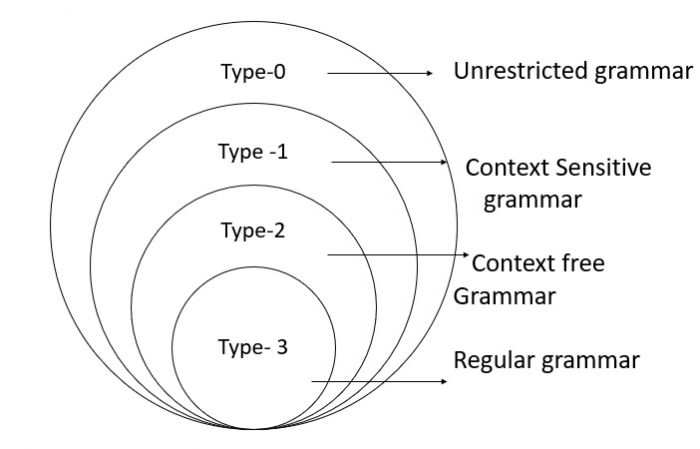
 Data Structure
Data Structure Networking
Networking RDBMS
RDBMS Operating System
Operating System Java
Java MS Excel
MS Excel iOS
iOS HTML
HTML CSS
CSS Android
Android Python
Python C Programming
C Programming C++
C++ C#
C# MongoDB
MongoDB MySQL
MySQL Javascript
Javascript PHP
PHPPhysics
Chemistry
Biology
Mathematics
English
Economics
Psychology
Social Studies
Fashion Studies
Legal Studies
- Selected Reading
- UPSC IAS Exams Notes
- Developer's Best Practices
- Questions and Answers
- Effective Resume Writing
- HR Interview Questions
- Computer Glossary
- Who is Who
Explain Chomsky hierarchy in TOC
Chomsky Hierarchy represents the class of languages that are accepted by the different machines.
Chomsky hierarchy
Hierarchy of grammars according to Chomsky is explained below as per the grammar types −
Type 0 − It is an Unrestricted grammars
Unrestricted grammar − an unrestricted grammar is a 4-tuple (T,N,P,S), which consisting of −
T = set of terminals
N = set of nonterminal
P =as set of productions, of the form −
v->w
where v and w are strings consisting of nonterminal and terminals.
S = is called the start symbol.
Example − Turing Machine (TM)
Type 1 − Context-sensitive grammars
All productions are of form,
v -> w where |v| < |w|
uAv -> uwv with w != epsilon,
I.e., A -> w but only in the context of u _ v.
A context-sensitive grammar is equivalent to a linear bounded and context-sensitive language.
Example − Linear Bounded Automaton (LBA)
Type 3 − Context-free grammars −
All productions are of the form −
A -> x − where A is nonterminal, x is a string of nonterminal and terminals, A context-free grammar is equivalent to a pushdown automaton (PDA) and to context free languages.
Example − Pushdown Automaton (PDA)
Type 3 − Regular grammars
All productions are of the form −
A -> xB
A -> x where A, B are nonterminal, x is a string of terminals.
Regular grammars are equivalent to regular sets and to finite automata.
Example − Finite Automaton (FA)
| Grammar type | Grammar accepted | Language accepted | Automaton |
|---|---|---|---|
| Type 0 | unrestricted grammar | recursively enumerable language | Turing Machine |
| Type 1 | context-sensitive grammar | context-sensitive language | linear-bounded automata |
| Type 2 | Context-free grammar | Context-free language | Push down automata |
| Type 3 | regular grammar | regular language | finite state automaton |
The Chomsky hierarchy is depicted in the diagram given below −


